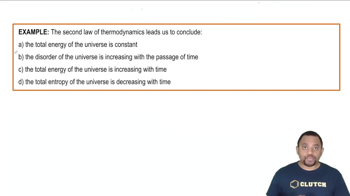Here are the essential concepts you must grasp in order to answer the question correctly.
Spontaneity of Reactions
A spontaneous process is one that occurs without external intervention, typically characterized by a decrease in free energy. Spontaneity is determined by the Gibbs free energy change (ΔG); if ΔG is negative, the process is spontaneous. This concept is crucial for understanding how reactions proceed in nature and the conditions under which they occur.
Recommended video:
Entropy and the Second Law of Thermodynamics
Entropy is a measure of disorder or randomness in a system, and the Second Law of Thermodynamics states that the total entropy of an isolated system can never decrease over time. In spontaneous processes, the total entropy of the universe (system plus surroundings) increases, which often drives reactions forward. Understanding entropy helps clarify why some reactions are spontaneous while others are not.
Recommended video:
Second Law of Thermodynamics Example
Role of Catalysts
Catalysts are substances that increase the rate of a chemical reaction without being consumed in the process. They work by lowering the activation energy required for the reaction to occur. However, catalysts do not change the spontaneity of a reaction; they cannot make a nonspontaneous reaction spontaneous, as they do not affect the overall energy change of the reaction.
Recommended video:
Catalyzed vs. Uncatalyzed Reactions
 Verified step by step guidance
Verified step by step guidance


